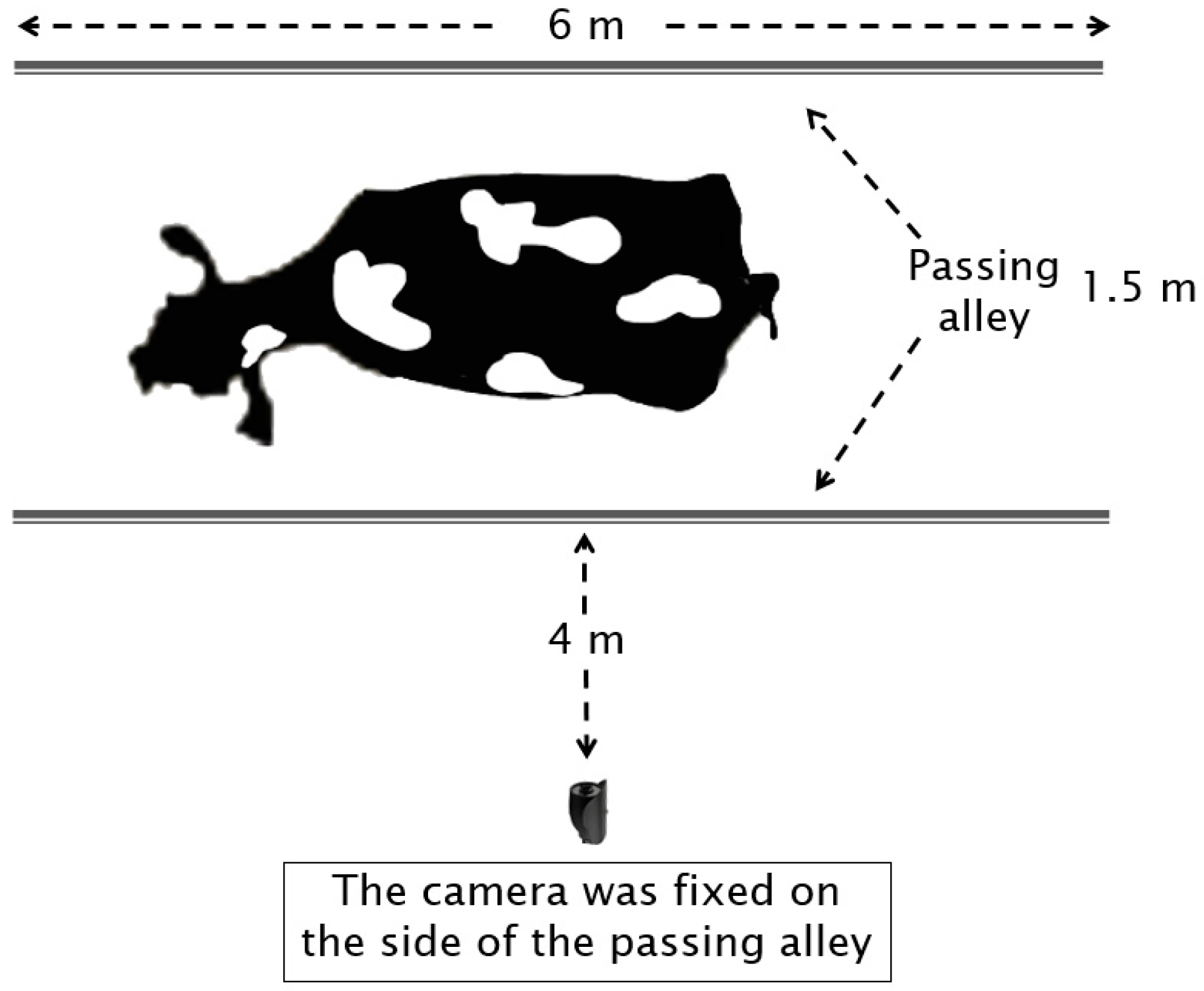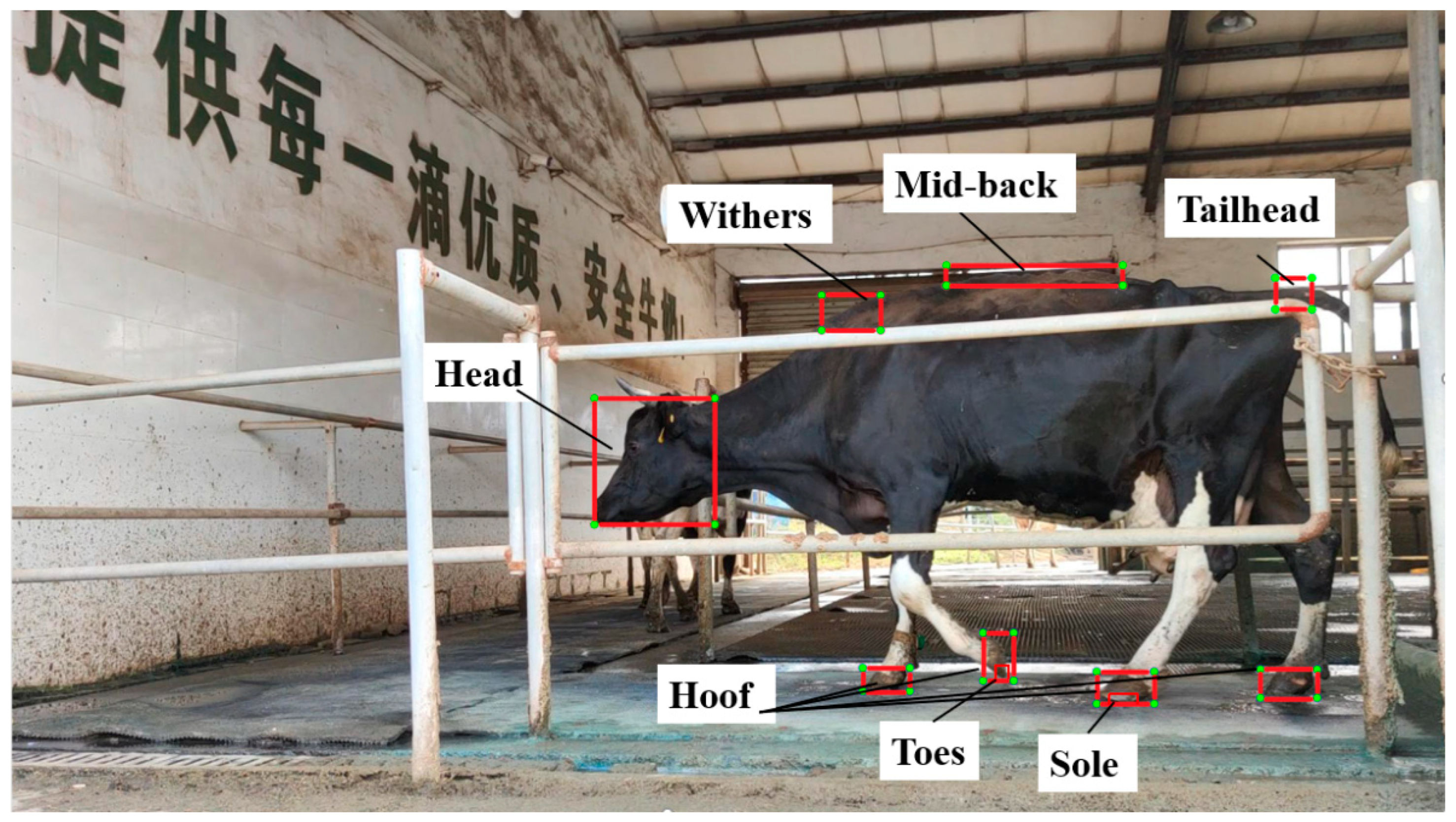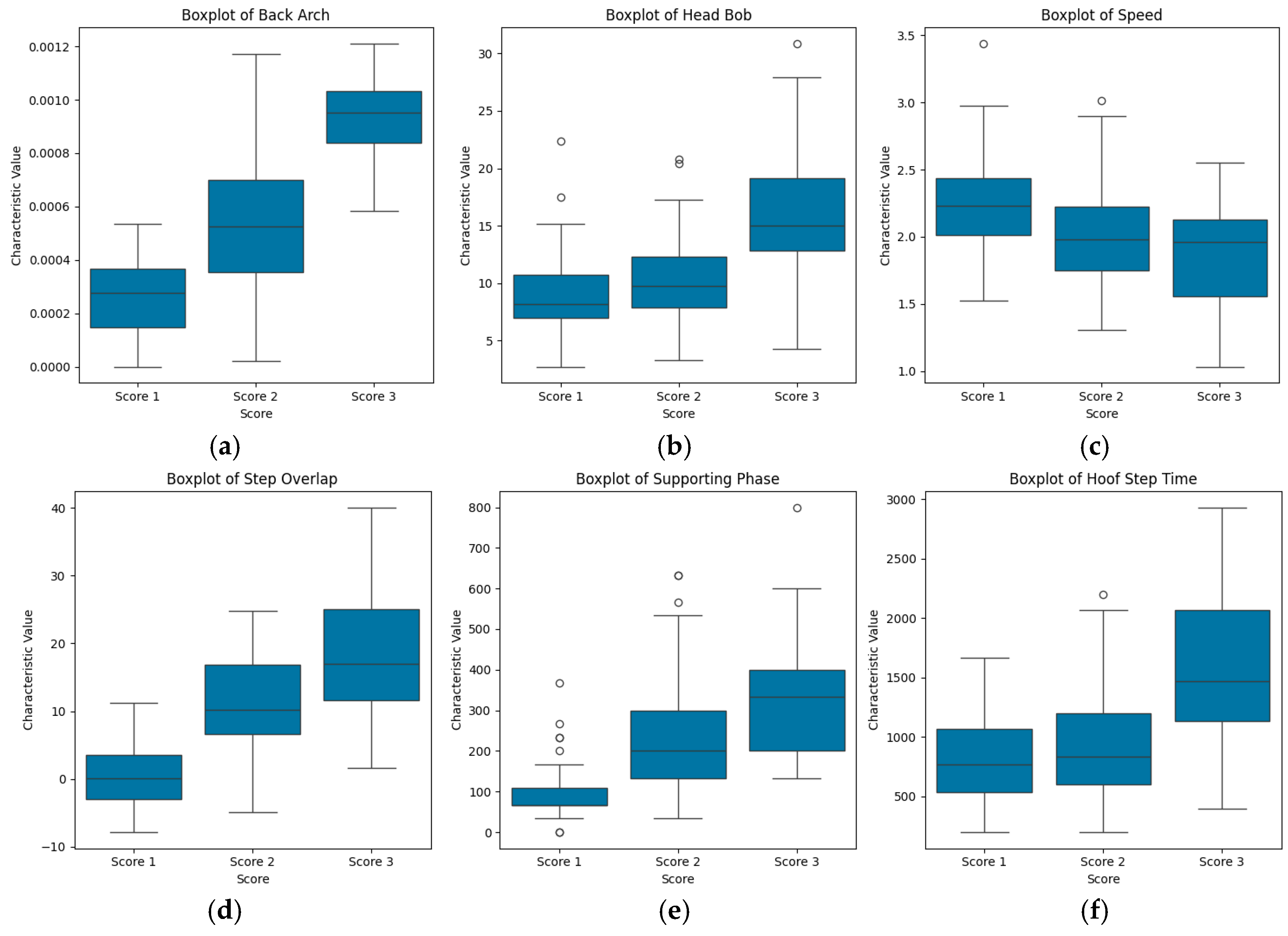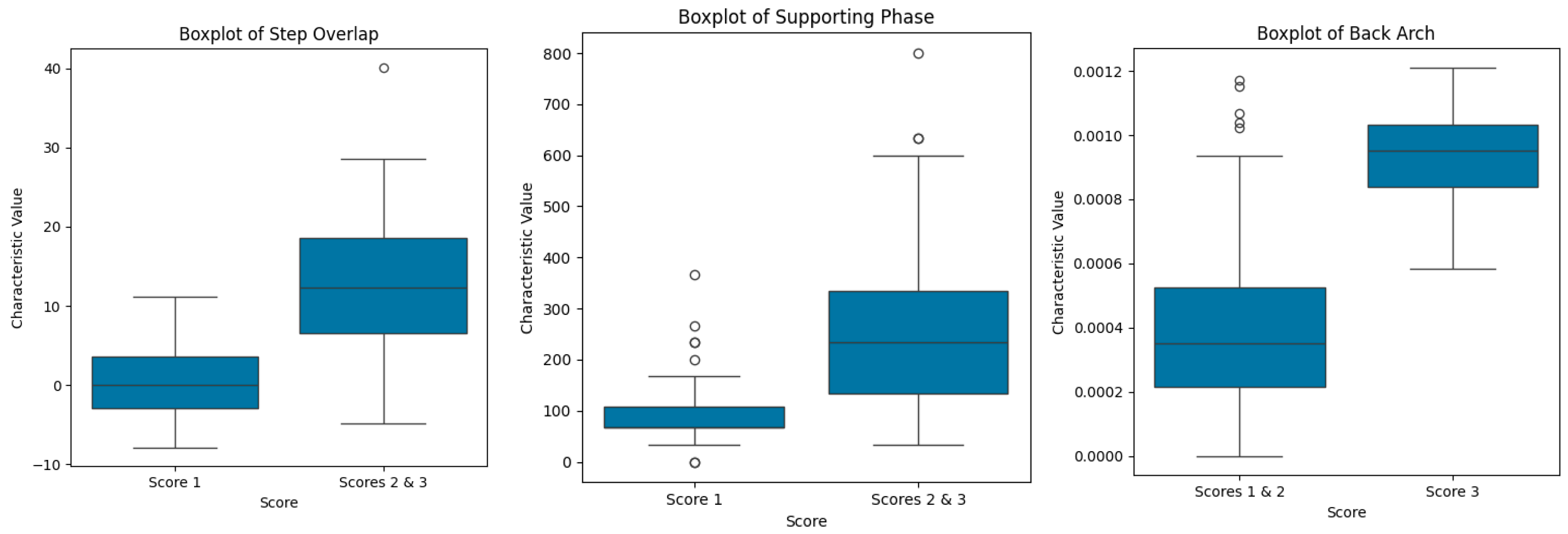Accuracy of Detecting Degrees of Lameness in Individual Dairy Cattle Within a Herd Using Single and Multiple Changes in Behavior and Gait
Simple Summary
Abstract
1. Introduction
2. Materials and Methods
2.1. Image Acquisition
2.2. Locomotion Scoring by Visual Observations
2.3. Characteristic Parameter Acquisition
2.4. Locomotion Score Prediction
3. Results
3.1. Descriptive Analysis and Correlation
3.2. Classification Accuracy
4. Discussion
4.1. Individual Specificity
4.2. Multiple-Parameter Detection
4.3. Characteristics and Detection Methods
5. Conclusions
Author Contributions
Funding
Institutional Review Board Statement
Informed Consent Statement
Data Availability Statement
Acknowledgments
Conflicts of Interest
References
- Botreau, R.; Bracke, M.B.; Perny, P.; Butterworth, A.; Capdeville, J.; Van Reenen, C.G.; Veissier, I. Aggregation of measures to produce an overall assessment of animal welfare. Part 2: Analysis of constraints. Animals 2007, 1, 1188–1197. [Google Scholar] [CrossRef] [PubMed]
- Green, L.E.; Hedges, V.J.; Schukken, Y.H.; Blowey, R.W.; Packington, A.J. The impact of clinical lameness on the milk yield of dairy cows. J. Dairy Sci. 2002, 85, 2250–2256. [Google Scholar] [CrossRef] [PubMed]
- Rees, G. Fate of a severely lame cow. Practice 2014, 36, 526–527. [Google Scholar] [CrossRef]
- Booth, C.J.; Warnick, L.D.; Groehn, Y.T.; Maizon, D.O.; Guard, C.L.; Janssen, D. Effect of lameness on culling in dairy cows. J. Dairy Sci. 2004, 87, 4115–4122. [Google Scholar] [CrossRef]
- Van Nuffel, A.; Zwertvaegher, I.; Pluym, L.; Van Weyenberg, S.; Thorup, V.M.; Pastell, M.; Sonck, B.; Saeys, W. Lameness detection in dairy cows: Part 1. How to distinguish between non-lame and lame cows based on differences in locomotion or behavior. Animals 2015, 5, 838–860. [Google Scholar] [CrossRef]
- Greenough, P.R.; MacCallum, F.J.; Weaver, A.D. Lameness in Cattle, 2nd ed.; Wright (Scientechnica): Bristol, UK, 1981. [Google Scholar]
- Pastell, M.; Hanninen, L.; de Passillé, A.M.; Rushen, J. Measures of weight distribution of dairy cows to detect lameness and the presence of hoof lesions. J. Dairy Sci. 2010, 93, 954–960. [Google Scholar] [CrossRef]
- Poikalainen, V.; Praks, J.; Kokin, E.; Aland, A.; Veemäe, I.; Peets, S.; Ahokas, J.; Pastell, M.; Hautala, M.; Berckmans, D.; et al. Elaboration of basic methods for automatic analysis of cows’ gait. Agron. Res. 2010, 8, 216–225. [Google Scholar]
- Maertens, W.; Vangeyte, J.; Baert, J.; Jantuan, A.; Mertens, K.C.; De Campeneere, S.; Pluk, A.; Opsomer, G.; Van Weyenberg, S.; Van Nuffel, A. Development of a real time cow gait tracking and analysing tool to assess lameness using a pressure sensitive walkway: The GAITWISE system. Biosyst. Eng. 2011, 110, 29–39. [Google Scholar] [CrossRef]
- Pastell, M.; Tiusanen, J.; Hakojärvi, M.; Hänninen, L. A wireless accelerometer system with wavelet analysis for assessing lameness in cattle. Biosyst. Eng. 2009, 104, 545–551. [Google Scholar] [CrossRef]
- Mandel, R.; Harazy, H.; Gygax, L.; Nicol, C.J.; Ben-David, A.; Whay, H.R.; Klement, E. Detection of lameness in dairy cows using a grooming device. J. Dairy Sci. 2018, 101, 1511–1517. [Google Scholar] [CrossRef]
- Song, X.Y.; Leroy, T.; Vranken, E.; Maertens, W.; Sonck, B.; Berckmans, D. Automatic detection of lameness in dairy cattle—Vision-based trackway analysis in cow’s locomotion. Comput. Electron. Agric. 2008, 64, 39–44. [Google Scholar] [CrossRef]
- Viazzi, S.; Bahr, C.; Van Hertem, T.; Schlageter-Tello, A.; Romanini, C.E.B.; Halachmi, I.; Lokhorst, C.; Berckmans, D. Comparison of a three-dimensional and two-dimensional camera system for automated measurement of back posture in dairy cows. Comput. Electron. Agric. 2014, 100, 139–147. [Google Scholar] [CrossRef]
- Zhao, K.; Bewley, J.M.; He, D.; Jin, X. Automatic lameness detection in dairy cattle based on leg swing analysis with an image processing technique. Comput. Electron. Agric. 2018, 148, 226–236. [Google Scholar] [CrossRef]
- Russello, H.; van der Tol, R.; Holzhauer, M.; van Henten, E.J.; Kootstra, G. Video-based automatic lameness detection of dairy cows using pose estimation and multiple locomotion traits. Comput. Electron. Agric. 2024, 223, 12. [Google Scholar] [CrossRef]
- Myint, B.B.; Onizuka, T.; Tin, P.; Aikawa, M.; Kobayashi, I.; Zin, T.T. Development of a real-time cattle lameness detection system using a single side-view camera. Sci. Rep. 2024, 14, 22. [Google Scholar] [CrossRef]
- Jiang, B.; Song, H.B.; He, D.J. Lameness detection of dairy cows based on a double normal background statistical model. Comput. Electron. Agric. 2019, 158, 140–149. [Google Scholar] [CrossRef]
- Scott, G.B. Changes in limb loading with lameness for a number of friesian cattle. Br. Vet. J. 1989, 145, 28–38. [Google Scholar] [CrossRef]
- Hoffman, A.C.; Moore, D.A.; Vanegas, J.; Wenz, J.R. Association of abnormal hind-limb postures and back arch with gait abnormality in dairy cattle. J. Dairy Sci. 2014, 97, 2178–2185. [Google Scholar] [CrossRef]
- Pluk, A.; Bahr, C.; Poursaberi, A.; Maertens, W.; van Nuffel, A.; Berckmans, D. Automatic measurement of touch and release angles of the fetlock joint for lameness detection in dairy cattle using vision techniques. J. Dairy Sci. 2012, 95, 1738–1748. [Google Scholar] [CrossRef]
- Kang, X.; Zhang, X.D.; Liu, G. A Review: Development of Computer Vision-Based Lameness Detection for Dairy Cows and Discussion of the Practical Applications. Sensors 2021, 21, 26. [Google Scholar] [CrossRef]
- Poursaberi, A.; Bahr, C.; Pluk, A.; Van Nuffel, A.; Berckmans, D. Real-time automatic lameness detection based on back posture extraction in dairy cattle: Shape analysis of cow with image processing techniques. Comput. Electron. Agric. 2010, 74, 110–119. [Google Scholar] [CrossRef]
- Viazzi, S.; Bahr, C.; Schlageter-Tello, A.; Van Hertem, T.; Romanini, C.E.B.; Pluk, A.; Halachmi, I.; Lokhorst, C.; Berckmans, D. Analysis of individual classification of lameness using automatic measurement of back posture in dairy cattle. J. Dairy Sci. 2013, 96, 257–266. [Google Scholar] [CrossRef] [PubMed]
- Piette, D.; Norton, T.; Exadaktylos, V.; Berckmans, D. Individualised automated lameness detection in dairy cows and the impact of historical window length on algorithm performance. Animal 2020, 14, 409–417. [Google Scholar] [CrossRef] [PubMed]
- Zhao, K.; Zhang, M.; Ji, J.; Zhang, R.; Bewley, J.M. Automatic lameness scoring of dairy cows based on the analysis of head- and back-hoof linkage features using machine learning methods. Biosyst. Eng. 2023, 230, 424–441. [Google Scholar] [CrossRef]
- Li, Q.; Si, Y.S.; Chu, M.Y.; Liu, N.; Kang, X.; Liu, G. A novel lameness detection method for dairy cows based on temporal gait and spatial post features. Comput. Electron. Agric. 2024, 224, 13. [Google Scholar] [CrossRef]
- Flower, F.C.; Weary, D.M. Gait assessment in dairy cattle. Animal 2009, 3, 87–95. [Google Scholar] [CrossRef]
- Zillner, J.C.; Tücking, N.; Plattes, S.; Heggemann, T.; Büscher, W. Using walking speed for lameness detection in lactating dairy cows. Livest. Sci. 2018, 218, 119–123. [Google Scholar] [CrossRef]
- Kang, X.; Zhang, X.D.; Liu, G. Accurate detection of lameness in dairy cattle with computer vision: A new and individualized detection strategy based on the analysis of the supporting phase. J. Dairy Sci. 2020, 103, 10628–10638. [Google Scholar] [CrossRef]
- Bahr, C.; Leroy, T.; Song, X.; Vranken, E.; Maertens, W.; Vangeyte, J.; Van Nuffel, A.; Sonck, B.; Berckmans, D. Automatic detection of lameness in dairy cattle–analyzing image parameters related to lameness. In Proceedings of the American Society of Agricultural and Biological Engineers, Reno, NV, USA, 31 August–4 September 2009; Livestock Environment VIII: Iguassu Falls, Brazil, 2009. [Google Scholar]
- Cortes, C.; Vapnik, V. Support-vector networks. Mach. Learn. 1995, 20, 273–297. [Google Scholar] [CrossRef]
- Quinlan, J.R. Induction of decision trees. Mach. Learn. 1986, 1, 81–106. [Google Scholar] [CrossRef]
- Hosmer, D.W.; Lemeshow, S. Applied Logistic Regression, 2nd ed.; Wiley: New York, NY, USA, 2000; pp. 1–392. [Google Scholar]
- Lundberg, S.M.; Lee, S.I. A unified approach to interpreting model predictions. Adv. Neural Inf. Process. Syst. 2017, 30, 4765–4774. [Google Scholar]
- Kohavi, R. A Study of Cross-Validation and Bootstrap for Accuracy Estimation and Model Selection. In Proceedings of the International Joint Conference on Artificial Intelligence, Montreal, QC, Canada, 20–25 August 1995; Morgan Kaufmann: San Francisco, CA, USA, 1995; pp. 1137–1145. [Google Scholar]
- Sprecher, D.J.; Hostetler, D.E.; Kaneene, J.B. A lameness scoring system that uses posture and gait to predict dairy cattle reproductive performance. Theriogenology 1997, 47, 1179–1187. [Google Scholar] [CrossRef] [PubMed]
- Winckler, C.; Willen, S. The reliability and repeatability of a lameness scoring system for use as an indicator of welfare in dairy cattle. Acta Agric. Scand. Sect. A-Anim. Sci. 2001, 51, 103–107. [Google Scholar] [CrossRef]
- Barney, S.; Dlay, S.; Crowe, A.; Kyriazakis, I.; Leach, M. Deep learning pose estimation for multi-cattle lameness detection. Sci. Rep. 2023, 13, 4499. [Google Scholar] [CrossRef]
- Li, Q.; He, Z.J.; Liu, X.W.; Chu, M.Y.; Wang, Y.C.; Kang, X.; Liu, G. Lameness detection system for dairy cows based on instance segmentation. Expert Syst. Appl. 2024, 249, 123775. [Google Scholar] [CrossRef]
- Haladjian, J.; Hodaie, Z.; Nüske, S.; Brügge, B. Gait Anomaly Detection in Dairy Cattle. In Proceedings of the Fourth International Conference on Animal-Computer Interaction, Milton Keynes, UK, 21–23 November 2017; ACM: New York, NY, USA, 2017; pp. 1–8. [Google Scholar]
- Gardenier, J.; Underwood, J.; Clark, C. Object Detection for Cattle Gait Tracking. In Proceedings of the 2018 IEEE International Conference on Robotics and Automation (ICRA), Brisbane, Australia, 21–25 May 2018; IEEE: Piscataway, NJ, USA, 2018; pp. 2206–2213. [Google Scholar]
- Van Nuffel, A.; Vangeyte, J.; Mertens, K.C.; Pluym, L.; De Campeneere, S.; Saeys, W.; Opsomer, G.; Van Weyenberg, S. Exploration of measurement variation of gait variables for early lameness detection in cattle using the GAITWISE. Livest. Sci. 2013, 156, 88–95. [Google Scholar] [CrossRef]





| Score | Description |
|---|---|
| 1 | The cow walks with a level-back posture. The gait is normal. No signs of head bob when the cow is walking. |
| 2 | In most cases, the back is arched when the cow is walking. The gait might be slightly uneven and the cow may walk with short strides. In most cases, there are no signs of head bob when walking. |
| 3 | The back is visibly arched when the cow is walking. The cow is obviously lame on 1 or more legs. The cow is unable, unwilling, or very reluctant to bear weight on the affected leg. In most cases, head bob will be evident when walking. |
| Reference | Summary of the Methods | Outcome | Expression | Interpretation |
|---|---|---|---|---|
| Poursaberi [22] | Three points (hip point, shoulder point, middle point) were used to measure the curvature of the back, and two thresholds were used to implement the classification. | 96% correct rate of classification | where R denotes the radius of the circle passing through three points, and k denotes the curvature of the back. | |
| Flower [27] | Continuous 100-unit scales were used to assessed 6 gait attributes: back arch, head bob, tracking-up, joint flexion, asymmetric gait, and reluctance to bear weight. | 92% correct rate of classification | - | - |
| Russello [15] | The amplitude of the vertical movement of the forehead keypoint was used as a measure of head bobbing. | Head bobbing amplitude displayed a clear demarcation between the normal and lame classes. | n) | where H denotes the maximum of the cow’s head amplitude, hhi denotes the highest location of the center of the cow’s head, hli denotes the lowest location of the center of the cow’s head, and denotes the number of times the cow’s head swings. |
| Zillner [28] | Speed of cows was taken by a standard stopwatch, and statistical data analysis was carried out using SPSS version 23. | The sensitivity was 71.43%, and the specificity was 78.57%. | where denotes the walking speed, is the length of the test track, and denotes the time needed to cover the test track. | |
| Song [12] | Linear relation between step overlaps and human visual locomotion scores was analyzed. | The step overlaps had a positive linear relationship to the visual locomotion scores. | denotes the step overlap of the left side, and denotes the step overlap of the right side. denotes the maximum values of . | |
| Kang [29] | The Spearman rank correlation coefficient was calculated for the locomotion score and the difference in the supporting phases. | The correlation coefficient was 0.864. | where is the time of hoof toe being com-pletely lifted off the ground, and is the time of hoof sole being fully loaded. | |
| Bahr [30] | The correlation between hoof step time and visual locomotion scores was analyzed. | The correlation coefficient was 0.84. | where denotes the step time of the hoof, denotes the time that the hoof touches the ground, denotes the time that the hoof is lifted off the ground, denotes the time of the first stride, denotes the time of the second stride, and denotes the corresponding times of both strides. |
| Characteristic | Back Arch | Head Bob (cm) | Speed (m/s) | Step Overlap (cm) | Supporting Phase (ms) | Hoof Step Time (ms) |
|---|---|---|---|---|---|---|
| Average values of Score 1 | 2.7 × 10−4 | 9.0 | 2.2 | 0.8 | 93.1 | 821.6 |
| Average values of Score 2 | 5.4 × 10−4 | 10.1 | 2.0 | 11.3 | 225.4 | 941.8 |
| Average values of Score 3 | 9.5 × 10−4 | 15.8 | 1.9 | 17.3 | 318.0 | 1576.9 |
| Characteristic | Algorithm | Accuracy (%) | Sensitivity of Score 1 | Specificity of Score 1 | Sensitivity of Score 2 | Specificity of Score 2 | Sensitivity of Score 3 | Specificity of Score 3 | Macro-F1 |
|---|---|---|---|---|---|---|---|---|---|
| Back arch | Support vector machine | 74 | 0.84 | 0.74 | 0.48 | 0.79 | 0.63 | 0.96 | 0.69 |
| Decision tree learning | 66 | 0.69 | 0.78 | 0.48 | 0.71 | 0.77 | 0.91 | 0.65 | |
| Logistic regression | 75 | 0.84 | 0.67 | 0.48 | 0.79 | 0.63 | 0.96 | 0.69 | |
| Head bob | Support vector machine | 71 | 0.38 | 0.66 | 0.01 | 0.99 | 0.38 | 0.98 | 0.37 |
| Decision tree learning | 52 | 0.61 | 0.62 | 0.47 | 0.72 | 0.53 | 0.88 | 0.53 | |
| Logistic regression | 80 | 0.61 | 0.61 | 0.01 | 0.99 | 0.35 | 0.98 | 0.45 | |
| Speed | Support vector machine | 71 | 0.65 | 0.64 | 0.23 | 0.85 | 0.01 | 0.99 | 0.41 |
| Decision tree learning | 44 | 0.55 | 0.67 | 0.45 | 0.58 | 0.28 | 0.89 | 0.43 | |
| Logistic regression | 71 | 0.55 | 0.75 | 0.02 | 0.98 | 0.01 | 0.99 | 0.30 | |
| Trackway overlap | Support vector machine | 79 | 0.81 | 0.81 | 0.62 | 0.73 | 0.10 | 0.90 | 0.62 |
| Decision tree learning | 53 | 0.65 | 0.82 | 0.56 | 0.68 | 0.37 | 0.82 | 0.53 | |
| Logistic regression | 69 | 0.81 | 0.80 | 0.55 | 0.75 | 0.20 | 0.97 | 0.59 | |
| Supporting phase | Support vector machine | 77 | 0.83 | 0.76 | 0.58 | 0.73 | 0.01 | 0.99 | 0.58 |
| Decision tree learning | 62 | 0.75 | 0.81 | 0.46 | 0.73 | 0.18 | 0.92 | 0.53 | |
| Logistic regression | 50 | 0.86 | 0.74 | 0.50 | 0.76 | 0.10 | 0.97 | 0.51 | |
| Hoof step time | Support vector machine | 80 | 0.26 | 0.80 | 0.05 | 0.93 | 0.30 | 0.98 | 0.31 |
| Decision tree learning | 54 | 0.69 | 0.54 | 0.36 | 0.65 | 0.40 | 0.93 | 0.50 | |
| Logistic regression | 79 | 0.63 | 0.56 | 0.01 | 0.99 | 0.35 | 0.99 | 0.45 | |
| Multiple parameters | Support vector machine | 85 | 0.95 | 0.93 | 0.74 | 0.89 | 0.63 | 0.95 | 0.81 |
| Decision tree learning | 84 | 0.88 | 0.93 | 0.82 | 0.84 | 0.73 | 0.97 | 0.82 | |
| Logistic regression | 82 | 0.94 | 0.93 | 0.69 | 0.88 | 0.72 | 0.94 | 0.80 |
| Algorithm | Back Arch | Head Bob | Speed | Step Overlap | Supporting Phase | Hoof Step Time |
|---|---|---|---|---|---|---|
| Support vector machine | 0.89 | 0.07 | 0.34 | 1.86 | 1.17 | 0.19 |
| Decision tree learning | 0.320 | 0.102 | 0.084 | 0.326 | 0.111 | 0.057 |
| Logistic regression | 1.17 | 0.16 | 0.42 | 2.30 | 1.60 | 0.16 |
Disclaimer/Publisher’s Note: The statements, opinions and data contained in all publications are solely those of the individual author(s) and contributor(s) and not of MDPI and/or the editor(s). MDPI and/or the editor(s) disclaim responsibility for any injury to people or property resulting from any ideas, methods, instructions or products referred to in the content. |
© 2025 by the authors. Licensee MDPI, Basel, Switzerland. This article is an open access article distributed under the terms and conditions of the Creative Commons Attribution (CC BY) license (https://creativecommons.org/licenses/by/4.0/).
Share and Cite
Kang, X.; Liang, J.; Li, Q.; Liu, G. Accuracy of Detecting Degrees of Lameness in Individual Dairy Cattle Within a Herd Using Single and Multiple Changes in Behavior and Gait. Animals 2025, 15, 1144. https://doi.org/10.3390/ani15081144
Kang X, Liang J, Li Q, Liu G. Accuracy of Detecting Degrees of Lameness in Individual Dairy Cattle Within a Herd Using Single and Multiple Changes in Behavior and Gait. Animals. 2025; 15(8):1144. https://doi.org/10.3390/ani15081144
Chicago/Turabian StyleKang, Xi, Junjie Liang, Qian Li, and Gang Liu. 2025. "Accuracy of Detecting Degrees of Lameness in Individual Dairy Cattle Within a Herd Using Single and Multiple Changes in Behavior and Gait" Animals 15, no. 8: 1144. https://doi.org/10.3390/ani15081144
APA StyleKang, X., Liang, J., Li, Q., & Liu, G. (2025). Accuracy of Detecting Degrees of Lameness in Individual Dairy Cattle Within a Herd Using Single and Multiple Changes in Behavior and Gait. Animals, 15(8), 1144. https://doi.org/10.3390/ani15081144







